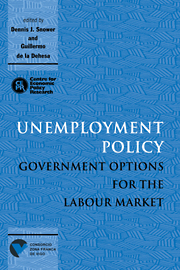Book contents
- Frontmatter
- Contents
- List of figures
- List of tables
- Preface
- Acknowledgements
- List of conference participants
- 1 Introduction
- PART ONE GENERAL POLICY ISSUES
- PART TWO DEMAND MANAGEMENT AND SUPPLY-SIDE POLICY
- PART THREE SUBSIDISING EMPLOYMENT AND TRAINING
- 6 The simple economics of benefit transfers
- Discussion
- Discussion
- 7 Wage subsidy programmes: alternative designs
- Discussion
- Discussion
- 8 Technological development, competition from low-wage economies and low-skilled unemployment
- Discussion
- 9 Macroeconomic and policy implications of shifts in the relative demand for skills
- Discussion
- 10 Would cutting payroll taxes on the unskilled have a significant impact on unemployment?
- Discussion
- 11 Preventing long-term unemployment: an economic analysis
- Discussion
- Discussion
- PART FOUR LABOUR MARKET REGULATIONS
- PART FIVE POLICY, JOB REALLOCATION AND THE UNEMPLOYMENT–PRODUCTIVITY RELATION
- PART SIX COMPARING UNEMPLOYMENT POLICIES
- Index
Discussion
Published online by Cambridge University Press: 07 September 2010
- Frontmatter
- Contents
- List of figures
- List of tables
- Preface
- Acknowledgements
- List of conference participants
- 1 Introduction
- PART ONE GENERAL POLICY ISSUES
- PART TWO DEMAND MANAGEMENT AND SUPPLY-SIDE POLICY
- PART THREE SUBSIDISING EMPLOYMENT AND TRAINING
- 6 The simple economics of benefit transfers
- Discussion
- Discussion
- 7 Wage subsidy programmes: alternative designs
- Discussion
- Discussion
- 8 Technological development, competition from low-wage economies and low-skilled unemployment
- Discussion
- 9 Macroeconomic and policy implications of shifts in the relative demand for skills
- Discussion
- 10 Would cutting payroll taxes on the unskilled have a significant impact on unemployment?
- Discussion
- 11 Preventing long-term unemployment: an economic analysis
- Discussion
- Discussion
- PART FOUR LABOUR MARKET REGULATIONS
- PART FIVE POLICY, JOB REALLOCATION AND THE UNEMPLOYMENT–PRODUCTIVITY RELATION
- PART SIX COMPARING UNEMPLOYMENT POLICIES
- Index
Summary
There are a number of conventional reasons for providing assistance to low-income individuals. Potential externalities are associated with high crime, poor health and cultural deprivation. In any case, there are equity arguments for redistribution. Phelps in chapter 7 introduces a third class of arguments. He claims, on the basis of an efficiency wage model, that significant labour market inefficiencies can be lessened by appropriate assistance to the low paid. This third rationale is important, not just in strengthening the case for assistance, but in indicating the appropriate methods.
Typically, if we are concerned about income distribution, we would introduce a benefits scheme rather than intervene in particular markets. Agricultural subsidies are the classic example of the problems associated with market intervention as a method of raising incomes. Phelps' particular focus is on the low paid in employment, as well as on the employed in this low-skills market. Schemes such as Family Credit in the UK have been introduced precisely to help out those in employment but on low wages. The advantage of a straightforward benefits scheme is that it can be targeted. Low-wage individuals may have alternative income sources, assets (such as a house), be part of a family group that has sufficient total income, and have differing needs, depending (for example) on the number of children. Since it is expensive in efficiency terms to raise revenues from taxation, targeting of benefits is important.
- Type
- Chapter
- Information
- Unemployment PolicyGovernment Options for the Labour Market, pp. 244 - 247Publisher: Cambridge University PressPrint publication year: 1997



